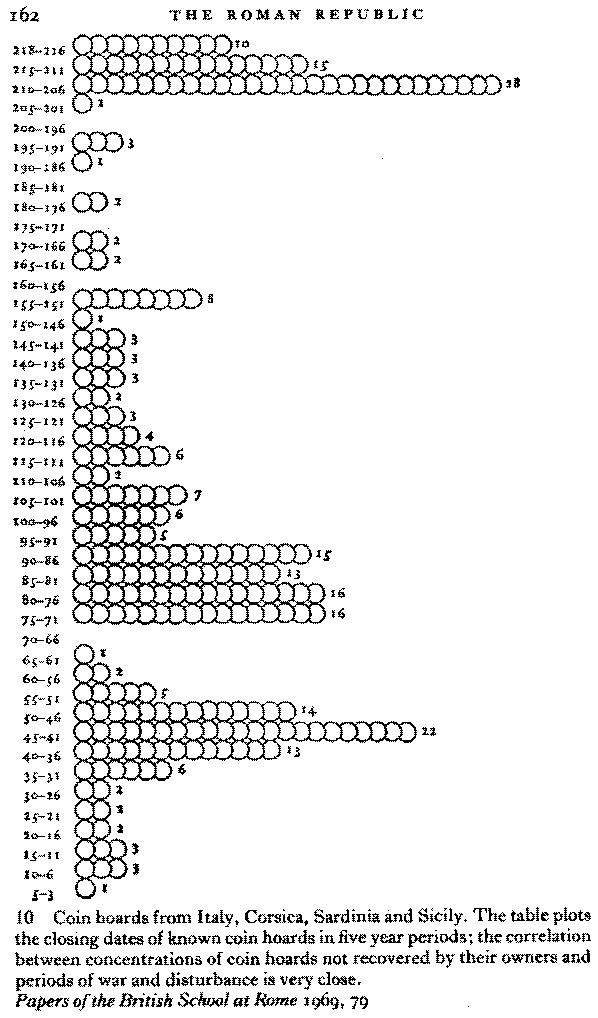You are right, it does come down to the assumed mechanism. But I believe you are wrong about the lack of objective tests in human systems like history. Let me give you an example. A direct consequence of my model for the early saeculum is that famines should be either more frequent or more severe during social moment turnings than during non-social moments. One way to test this would be to assess the frequence of famines by looking at the complete history of famines in various places over time and see if a saecular pattern emerges. No such records are known to me.
Another way to do the same thing is to look at the record of agricultural prices over time. During a famine prices spike upwards. A period of greater than normal frequency of famine should show a greater than normal volatility in agricultural prices. So we take a series of British agricultural prices and calculate a running standard deviation divided by the running average. This is a plot of running relative standard deviation which is a measure of trends in price volatility over time. Here is such a plot using a ten-year moving period.
Each peak indicates the end of a period of high price volatility, presumably a social moment. According to the model turnings are supposed to be 27 years long so let us draw a series of 27-year social moment turnings that end in the dates given in the chart and compare them social moment turnings given by McGuinness and S&H:
Proposed . McGuiness . . S&H
1176-1203 1174-1204
1222-1249 1230-1254
1293-1320 1305-1328
1352-1379 1348-1378
1418-1445 1415-1445 xxix-1435
1456-1483 xxxx-xxxx 1459-1487
1525-1552 xxxx-xxxx 1517-1542
1572-1599 xxxx-xxxx 1569-1594
1623-1650 xxxx-xxxx 1621-1649
It doesn't work too badly. As I mentioned before, unrest events line up with the turnings (and also with the cycle defined by the figure). It is not unreasonable that popular unrest would be greater during famine-filled (hard) times. It doesn't prove my mechanism, it could be a weather cycle that produces the apparent cycle in volatility, and the unrest, and the saeculum for that matter. Or something else. But it doesn't disprove the mechanism and so strengthens it.
The strength of this comparison relies on the assumption that S&H (and McGuinness) did not use price information to determine their dates. Neither mentions price behavior as a factor they considered and so I consider that the price volatily-based cycle I just constructed is independent of both S&H and McGuiness's saecula.
If you compare the centers of each turning with the centers of my proposed turnings you see they vary from 0 to 8 years apart. Now if there were no relation between the turnings I developed based on the chart and the other ones, then one would expect them to vary from 0 to 1 turning apart. (They can't be more than 1 turning away, because then they would be closer to the one on the other side.) If there were no relation, the spacing between the volatility turnings and the others would be closer than 1/2 of a turning (~13 years) half of the time and farther than 1/2 of a turning the other half of the time. We find that all nine spacings are less than 1/2 of a turning apart. This is like flipping nine coins and having all nine come up heads. The probability is 512 to 1 against that this relation between price volatility and turnings is co-incidence.
To get this excellent significance I have to use both S&H and McGuiness turnings in order to have lots of comparisons. If I just use S&H, I have only four comparisons--making it 4 heads with four coins, or a 1 in 16 probability of arising by chance. Even so, this is nearly significant.
Unfortunately this sort of analysis cannot be done for the Roman saeculum as there is no price series. However, if my proposed mechanism is valid, there is no reason to assume that it wouldn't be operational for Rome since it was an agricultural society. The key timing element would be age of generation turnover (at what age does the average woman produce a daughter who will live to reproduce). With 50% child mortality, and assuming some infertility and premature death of the mother, this would roughly be the age when the 5-6th child is born. Figure age of first child at 15-17 and ~2 year spacing, this gives 23-27 for the female. If I assume a couple of years older for the male, this gives about 26 years for generation turnover. During periods of population decline one might assume a higher mortality rate, which would give longer generations. During times of burgeoning population generations would be shorter.
Recall that this model does not apply to modern times so the shorter generations of today reflect something else.
- Join Date
- Jul 2001
- Location
- Kalamazoo MI
- Posts
- 4,502



